Tyrosine Kinase Inhibitors: A Review
VerifiedAdded on 2020/05/28
|13
|3297
|57
AI Summary
This assignment delves into the realm of tyrosine kinase inhibitors (TKIs), a class of drugs that target specific protein kinases involved in cell signaling pathways. It examines the mechanism of action of TKIs, their diverse applications in treating various cancers, including lung cancer and breast cancer, and the challenges associated with their development and use, such as resistance mechanisms and potential side effects. The assignment also discusses the ongoing research and advancements in TKI therapies, highlighting the potential for personalized medicine approaches based on genomic profiling.
Contribute Materials
Your contribution can guide someone’s learning journey. Share your
documents today.

Running head: TYROSINE KINASE INHIBITORS
Analysis of Drug Tyrosine Kinase Inhibitor
Name of the Student:
Name of the University:
Author Note:
Analysis of Drug Tyrosine Kinase Inhibitor
Name of the Student:
Name of the University:
Author Note:
Secure Best Marks with AI Grader
Need help grading? Try our AI Grader for instant feedback on your assignments.
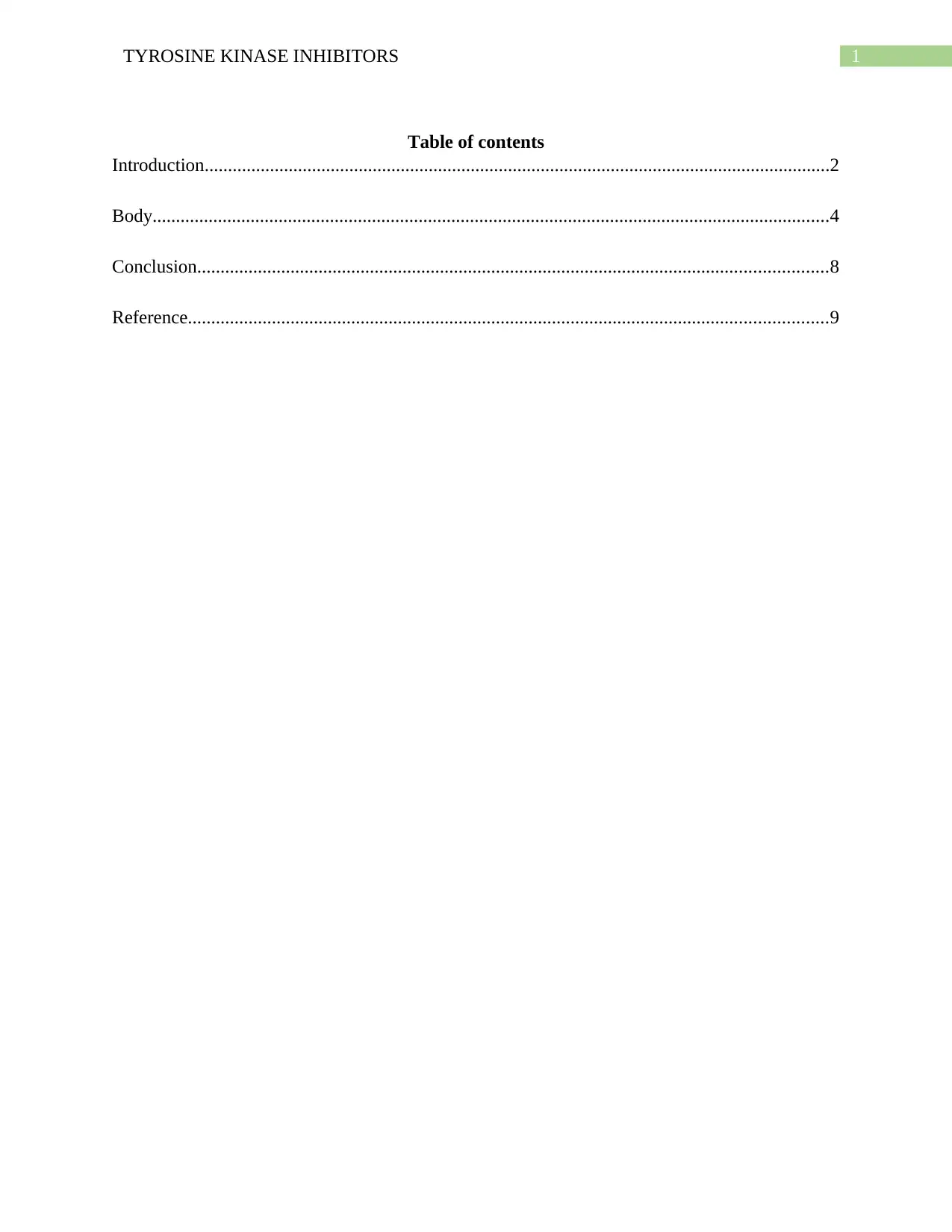
1TYROSINE KINASE INHIBITORS
Table of contents
Introduction......................................................................................................................................2
Body.................................................................................................................................................4
Conclusion.......................................................................................................................................8
Reference.........................................................................................................................................9
Table of contents
Introduction......................................................................................................................................2
Body.................................................................................................................................................4
Conclusion.......................................................................................................................................8
Reference.........................................................................................................................................9
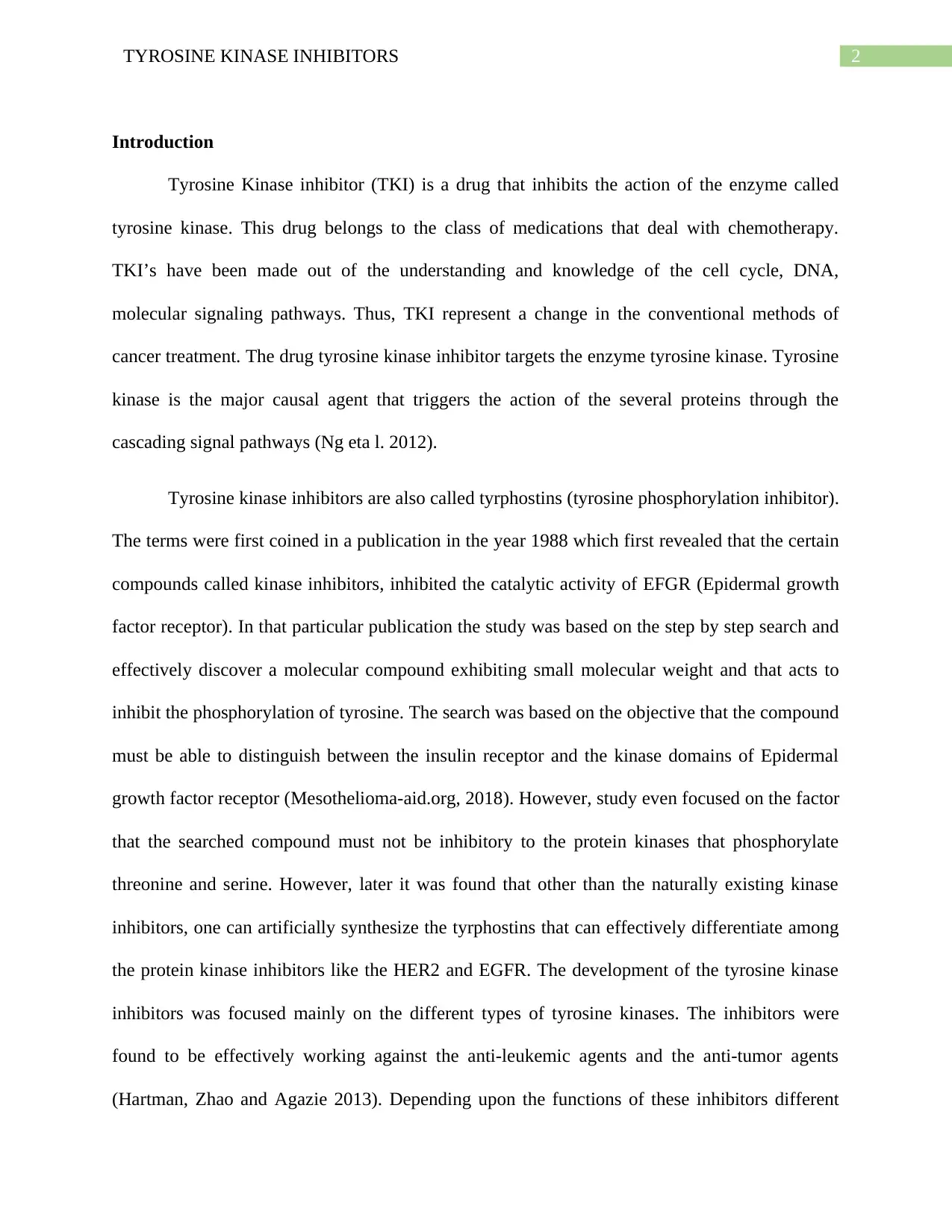
2TYROSINE KINASE INHIBITORS
Introduction
Tyrosine Kinase inhibitor (TKI) is a drug that inhibits the action of the enzyme called
tyrosine kinase. This drug belongs to the class of medications that deal with chemotherapy.
TKI’s have been made out of the understanding and knowledge of the cell cycle, DNA,
molecular signaling pathways. Thus, TKI represent a change in the conventional methods of
cancer treatment. The drug tyrosine kinase inhibitor targets the enzyme tyrosine kinase. Tyrosine
kinase is the major causal agent that triggers the action of the several proteins through the
cascading signal pathways (Ng eta l. 2012).
Tyrosine kinase inhibitors are also called tyrphostins (tyrosine phosphorylation inhibitor).
The terms were first coined in a publication in the year 1988 which first revealed that the certain
compounds called kinase inhibitors, inhibited the catalytic activity of EFGR (Epidermal growth
factor receptor). In that particular publication the study was based on the step by step search and
effectively discover a molecular compound exhibiting small molecular weight and that acts to
inhibit the phosphorylation of tyrosine. The search was based on the objective that the compound
must be able to distinguish between the insulin receptor and the kinase domains of Epidermal
growth factor receptor (Mesothelioma-aid.org, 2018). However, study even focused on the factor
that the searched compound must not be inhibitory to the protein kinases that phosphorylate
threonine and serine. However, later it was found that other than the naturally existing kinase
inhibitors, one can artificially synthesize the tyrphostins that can effectively differentiate among
the protein kinase inhibitors like the HER2 and EGFR. The development of the tyrosine kinase
inhibitors was focused mainly on the different types of tyrosine kinases. The inhibitors were
found to be effectively working against the anti-leukemic agents and the anti-tumor agents
(Hartman, Zhao and Agazie 2013). Depending upon the functions of these inhibitors different
Introduction
Tyrosine Kinase inhibitor (TKI) is a drug that inhibits the action of the enzyme called
tyrosine kinase. This drug belongs to the class of medications that deal with chemotherapy.
TKI’s have been made out of the understanding and knowledge of the cell cycle, DNA,
molecular signaling pathways. Thus, TKI represent a change in the conventional methods of
cancer treatment. The drug tyrosine kinase inhibitor targets the enzyme tyrosine kinase. Tyrosine
kinase is the major causal agent that triggers the action of the several proteins through the
cascading signal pathways (Ng eta l. 2012).
Tyrosine kinase inhibitors are also called tyrphostins (tyrosine phosphorylation inhibitor).
The terms were first coined in a publication in the year 1988 which first revealed that the certain
compounds called kinase inhibitors, inhibited the catalytic activity of EFGR (Epidermal growth
factor receptor). In that particular publication the study was based on the step by step search and
effectively discover a molecular compound exhibiting small molecular weight and that acts to
inhibit the phosphorylation of tyrosine. The search was based on the objective that the compound
must be able to distinguish between the insulin receptor and the kinase domains of Epidermal
growth factor receptor (Mesothelioma-aid.org, 2018). However, study even focused on the factor
that the searched compound must not be inhibitory to the protein kinases that phosphorylate
threonine and serine. However, later it was found that other than the naturally existing kinase
inhibitors, one can artificially synthesize the tyrphostins that can effectively differentiate among
the protein kinase inhibitors like the HER2 and EGFR. The development of the tyrosine kinase
inhibitors was focused mainly on the different types of tyrosine kinases. The inhibitors were
found to be effectively working against the anti-leukemic agents and the anti-tumor agents
(Hartman, Zhao and Agazie 2013). Depending upon the functions of these inhibitors different
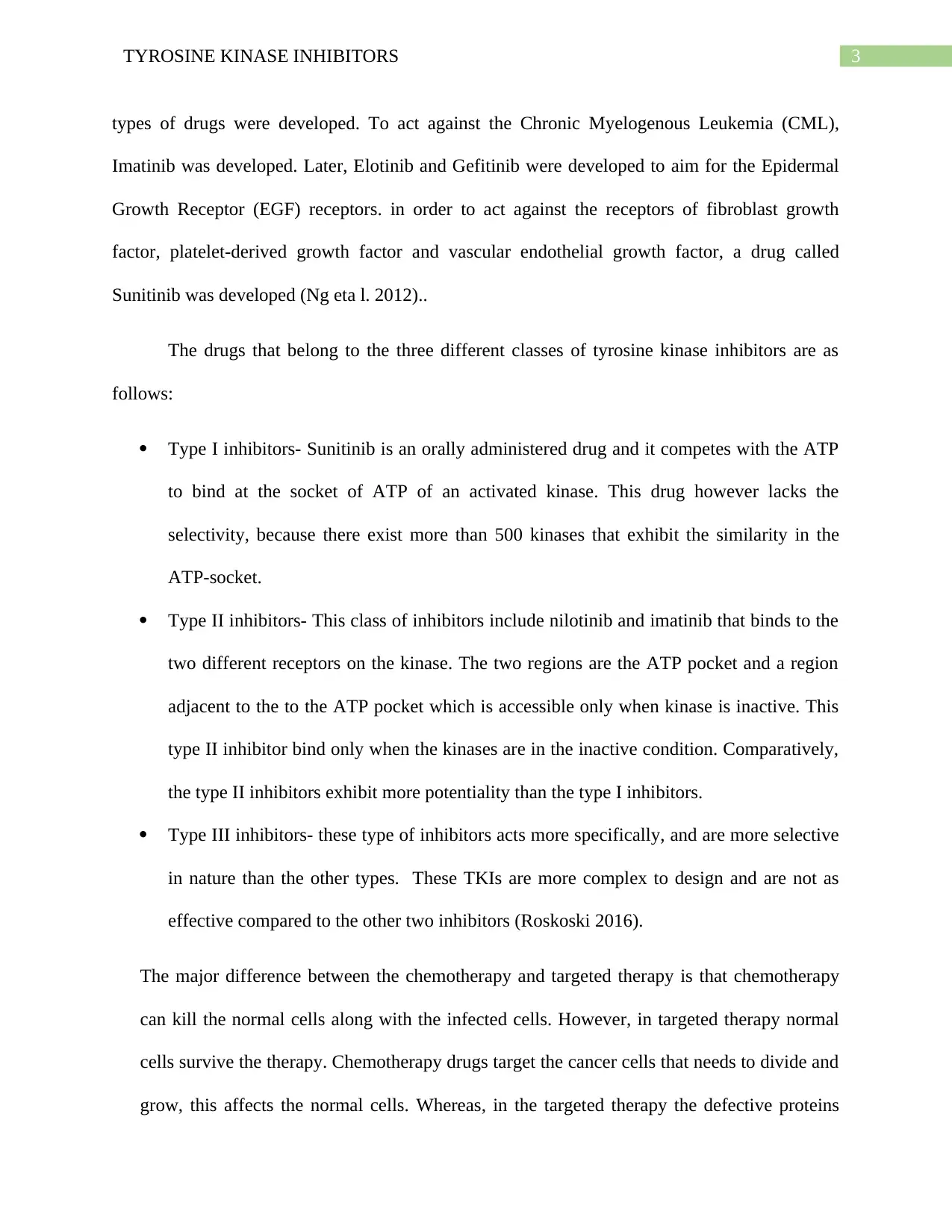
3TYROSINE KINASE INHIBITORS
types of drugs were developed. To act against the Chronic Myelogenous Leukemia (CML),
Imatinib was developed. Later, Elotinib and Gefitinib were developed to aim for the Epidermal
Growth Receptor (EGF) receptors. in order to act against the receptors of fibroblast growth
factor, platelet-derived growth factor and vascular endothelial growth factor, a drug called
Sunitinib was developed (Ng eta l. 2012)..
The drugs that belong to the three different classes of tyrosine kinase inhibitors are as
follows:
Type I inhibitors- Sunitinib is an orally administered drug and it competes with the ATP
to bind at the socket of ATP of an activated kinase. This drug however lacks the
selectivity, because there exist more than 500 kinases that exhibit the similarity in the
ATP-socket.
Type II inhibitors- This class of inhibitors include nilotinib and imatinib that binds to the
two different receptors on the kinase. The two regions are the ATP pocket and a region
adjacent to the to the ATP pocket which is accessible only when kinase is inactive. This
type II inhibitor bind only when the kinases are in the inactive condition. Comparatively,
the type II inhibitors exhibit more potentiality than the type I inhibitors.
Type III inhibitors- these type of inhibitors acts more specifically, and are more selective
in nature than the other types. These TKIs are more complex to design and are not as
effective compared to the other two inhibitors (Roskoski 2016).
The major difference between the chemotherapy and targeted therapy is that chemotherapy
can kill the normal cells along with the infected cells. However, in targeted therapy normal
cells survive the therapy. Chemotherapy drugs target the cancer cells that needs to divide and
grow, this affects the normal cells. Whereas, in the targeted therapy the defective proteins
types of drugs were developed. To act against the Chronic Myelogenous Leukemia (CML),
Imatinib was developed. Later, Elotinib and Gefitinib were developed to aim for the Epidermal
Growth Receptor (EGF) receptors. in order to act against the receptors of fibroblast growth
factor, platelet-derived growth factor and vascular endothelial growth factor, a drug called
Sunitinib was developed (Ng eta l. 2012)..
The drugs that belong to the three different classes of tyrosine kinase inhibitors are as
follows:
Type I inhibitors- Sunitinib is an orally administered drug and it competes with the ATP
to bind at the socket of ATP of an activated kinase. This drug however lacks the
selectivity, because there exist more than 500 kinases that exhibit the similarity in the
ATP-socket.
Type II inhibitors- This class of inhibitors include nilotinib and imatinib that binds to the
two different receptors on the kinase. The two regions are the ATP pocket and a region
adjacent to the to the ATP pocket which is accessible only when kinase is inactive. This
type II inhibitor bind only when the kinases are in the inactive condition. Comparatively,
the type II inhibitors exhibit more potentiality than the type I inhibitors.
Type III inhibitors- these type of inhibitors acts more specifically, and are more selective
in nature than the other types. These TKIs are more complex to design and are not as
effective compared to the other two inhibitors (Roskoski 2016).
The major difference between the chemotherapy and targeted therapy is that chemotherapy
can kill the normal cells along with the infected cells. However, in targeted therapy normal
cells survive the therapy. Chemotherapy drugs target the cancer cells that needs to divide and
grow, this affects the normal cells. Whereas, in the targeted therapy the defective proteins
Secure Best Marks with AI Grader
Need help grading? Try our AI Grader for instant feedback on your assignments.
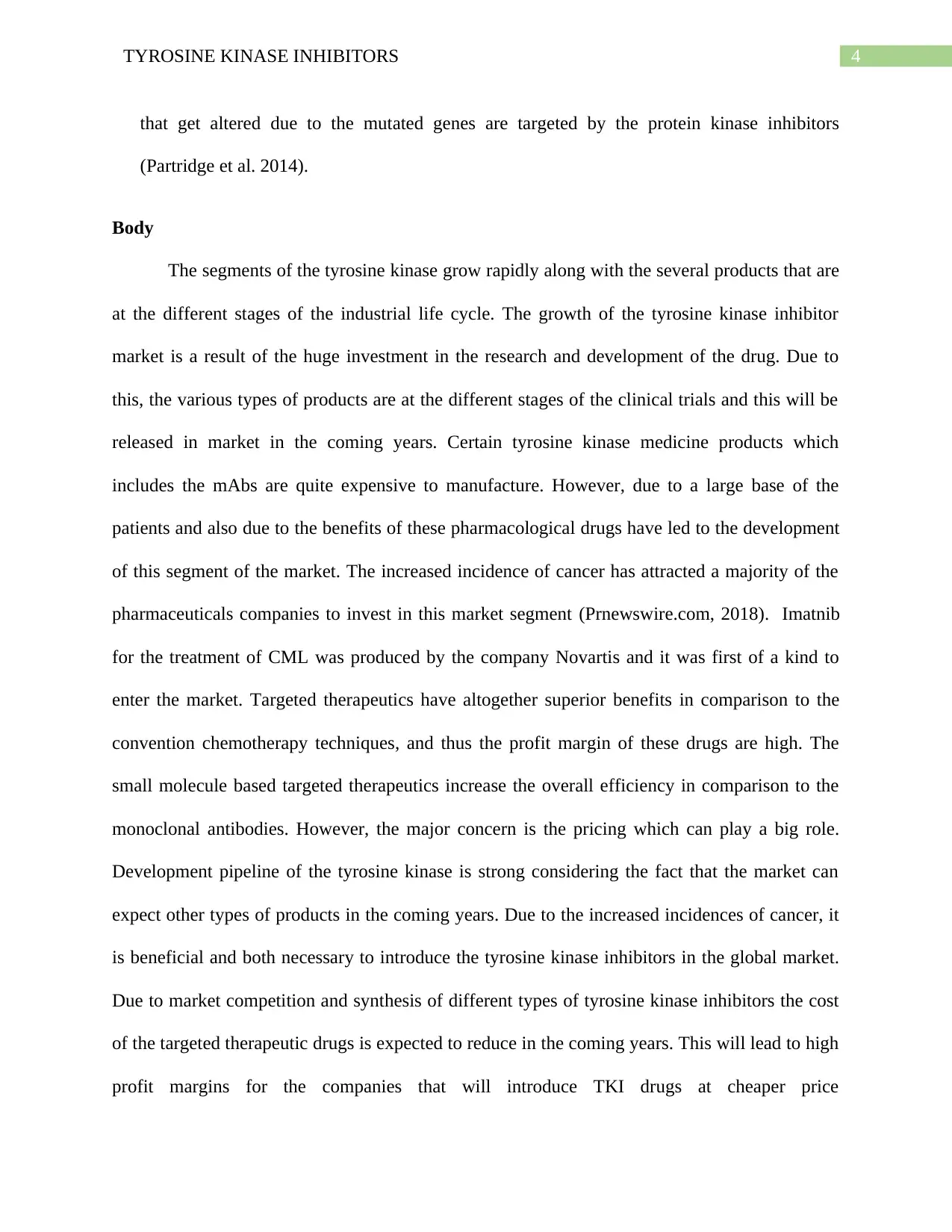
4TYROSINE KINASE INHIBITORS
that get altered due to the mutated genes are targeted by the protein kinase inhibitors
(Partridge et al. 2014).
Body
The segments of the tyrosine kinase grow rapidly along with the several products that are
at the different stages of the industrial life cycle. The growth of the tyrosine kinase inhibitor
market is a result of the huge investment in the research and development of the drug. Due to
this, the various types of products are at the different stages of the clinical trials and this will be
released in market in the coming years. Certain tyrosine kinase medicine products which
includes the mAbs are quite expensive to manufacture. However, due to a large base of the
patients and also due to the benefits of these pharmacological drugs have led to the development
of this segment of the market. The increased incidence of cancer has attracted a majority of the
pharmaceuticals companies to invest in this market segment (Prnewswire.com, 2018). Imatnib
for the treatment of CML was produced by the company Novartis and it was first of a kind to
enter the market. Targeted therapeutics have altogether superior benefits in comparison to the
convention chemotherapy techniques, and thus the profit margin of these drugs are high. The
small molecule based targeted therapeutics increase the overall efficiency in comparison to the
monoclonal antibodies. However, the major concern is the pricing which can play a big role.
Development pipeline of the tyrosine kinase is strong considering the fact that the market can
expect other types of products in the coming years. Due to the increased incidences of cancer, it
is beneficial and both necessary to introduce the tyrosine kinase inhibitors in the global market.
Due to market competition and synthesis of different types of tyrosine kinase inhibitors the cost
of the targeted therapeutic drugs is expected to reduce in the coming years. This will lead to high
profit margins for the companies that will introduce TKI drugs at cheaper price
that get altered due to the mutated genes are targeted by the protein kinase inhibitors
(Partridge et al. 2014).
Body
The segments of the tyrosine kinase grow rapidly along with the several products that are
at the different stages of the industrial life cycle. The growth of the tyrosine kinase inhibitor
market is a result of the huge investment in the research and development of the drug. Due to
this, the various types of products are at the different stages of the clinical trials and this will be
released in market in the coming years. Certain tyrosine kinase medicine products which
includes the mAbs are quite expensive to manufacture. However, due to a large base of the
patients and also due to the benefits of these pharmacological drugs have led to the development
of this segment of the market. The increased incidence of cancer has attracted a majority of the
pharmaceuticals companies to invest in this market segment (Prnewswire.com, 2018). Imatnib
for the treatment of CML was produced by the company Novartis and it was first of a kind to
enter the market. Targeted therapeutics have altogether superior benefits in comparison to the
convention chemotherapy techniques, and thus the profit margin of these drugs are high. The
small molecule based targeted therapeutics increase the overall efficiency in comparison to the
monoclonal antibodies. However, the major concern is the pricing which can play a big role.
Development pipeline of the tyrosine kinase is strong considering the fact that the market can
expect other types of products in the coming years. Due to the increased incidences of cancer, it
is beneficial and both necessary to introduce the tyrosine kinase inhibitors in the global market.
Due to market competition and synthesis of different types of tyrosine kinase inhibitors the cost
of the targeted therapeutic drugs is expected to reduce in the coming years. This will lead to high
profit margins for the companies that will introduce TKI drugs at cheaper price
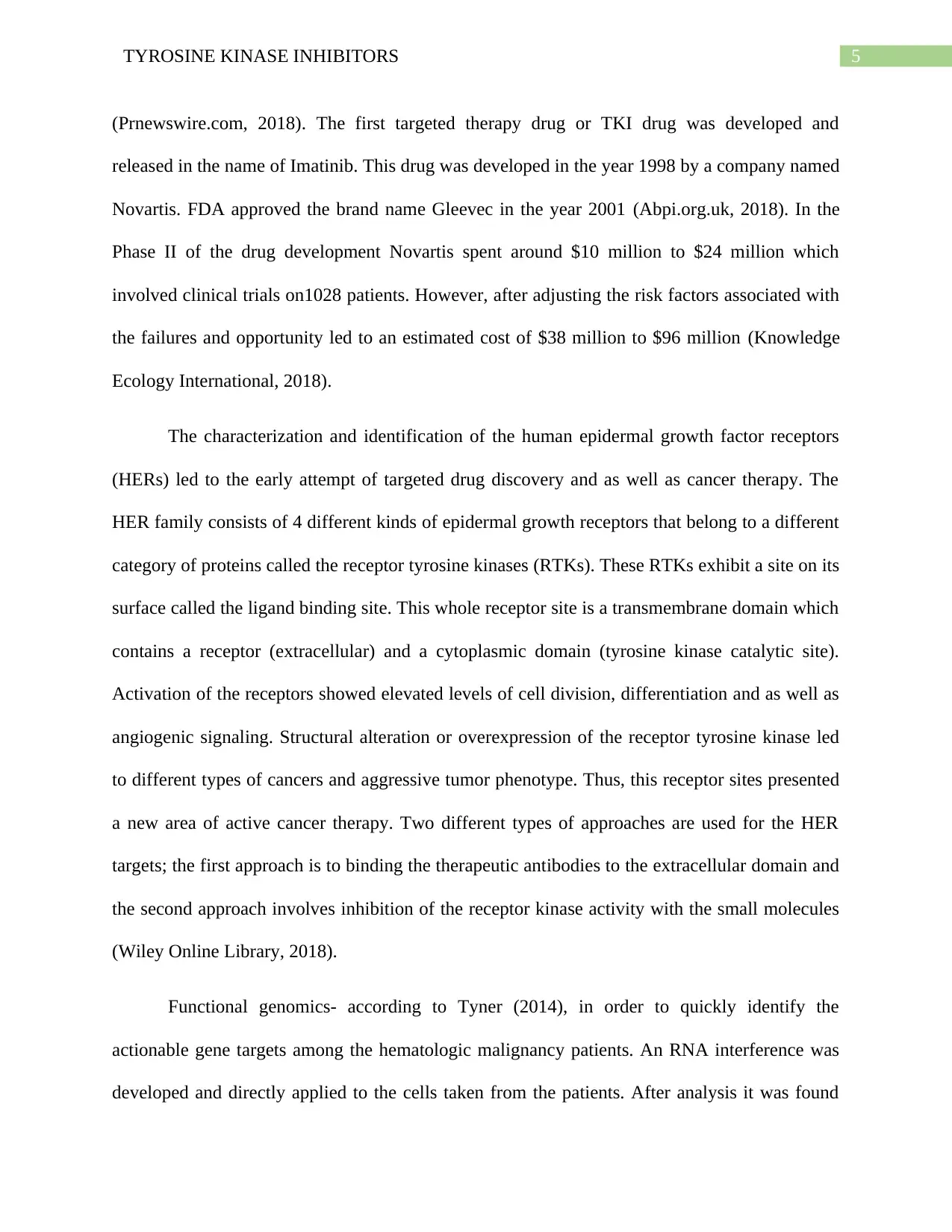
5TYROSINE KINASE INHIBITORS
(Prnewswire.com, 2018). The first targeted therapy drug or TKI drug was developed and
released in the name of Imatinib. This drug was developed in the year 1998 by a company named
Novartis. FDA approved the brand name Gleevec in the year 2001 (Abpi.org.uk, 2018). In the
Phase II of the drug development Novartis spent around $10 million to $24 million which
involved clinical trials on1028 patients. However, after adjusting the risk factors associated with
the failures and opportunity led to an estimated cost of $38 million to $96 million (Knowledge
Ecology International, 2018).
The characterization and identification of the human epidermal growth factor receptors
(HERs) led to the early attempt of targeted drug discovery and as well as cancer therapy. The
HER family consists of 4 different kinds of epidermal growth receptors that belong to a different
category of proteins called the receptor tyrosine kinases (RTKs). These RTKs exhibit a site on its
surface called the ligand binding site. This whole receptor site is a transmembrane domain which
contains a receptor (extracellular) and a cytoplasmic domain (tyrosine kinase catalytic site).
Activation of the receptors showed elevated levels of cell division, differentiation and as well as
angiogenic signaling. Structural alteration or overexpression of the receptor tyrosine kinase led
to different types of cancers and aggressive tumor phenotype. Thus, this receptor sites presented
a new area of active cancer therapy. Two different types of approaches are used for the HER
targets; the first approach is to binding the therapeutic antibodies to the extracellular domain and
the second approach involves inhibition of the receptor kinase activity with the small molecules
(Wiley Online Library, 2018).
Functional genomics- according to Tyner (2014), in order to quickly identify the
actionable gene targets among the hematologic malignancy patients. An RNA interference was
developed and directly applied to the cells taken from the patients. After analysis it was found
(Prnewswire.com, 2018). The first targeted therapy drug or TKI drug was developed and
released in the name of Imatinib. This drug was developed in the year 1998 by a company named
Novartis. FDA approved the brand name Gleevec in the year 2001 (Abpi.org.uk, 2018). In the
Phase II of the drug development Novartis spent around $10 million to $24 million which
involved clinical trials on1028 patients. However, after adjusting the risk factors associated with
the failures and opportunity led to an estimated cost of $38 million to $96 million (Knowledge
Ecology International, 2018).
The characterization and identification of the human epidermal growth factor receptors
(HERs) led to the early attempt of targeted drug discovery and as well as cancer therapy. The
HER family consists of 4 different kinds of epidermal growth receptors that belong to a different
category of proteins called the receptor tyrosine kinases (RTKs). These RTKs exhibit a site on its
surface called the ligand binding site. This whole receptor site is a transmembrane domain which
contains a receptor (extracellular) and a cytoplasmic domain (tyrosine kinase catalytic site).
Activation of the receptors showed elevated levels of cell division, differentiation and as well as
angiogenic signaling. Structural alteration or overexpression of the receptor tyrosine kinase led
to different types of cancers and aggressive tumor phenotype. Thus, this receptor sites presented
a new area of active cancer therapy. Two different types of approaches are used for the HER
targets; the first approach is to binding the therapeutic antibodies to the extracellular domain and
the second approach involves inhibition of the receptor kinase activity with the small molecules
(Wiley Online Library, 2018).
Functional genomics- according to Tyner (2014), in order to quickly identify the
actionable gene targets among the hematologic malignancy patients. An RNA interference was
developed and directly applied to the cells taken from the patients. After analysis it was found
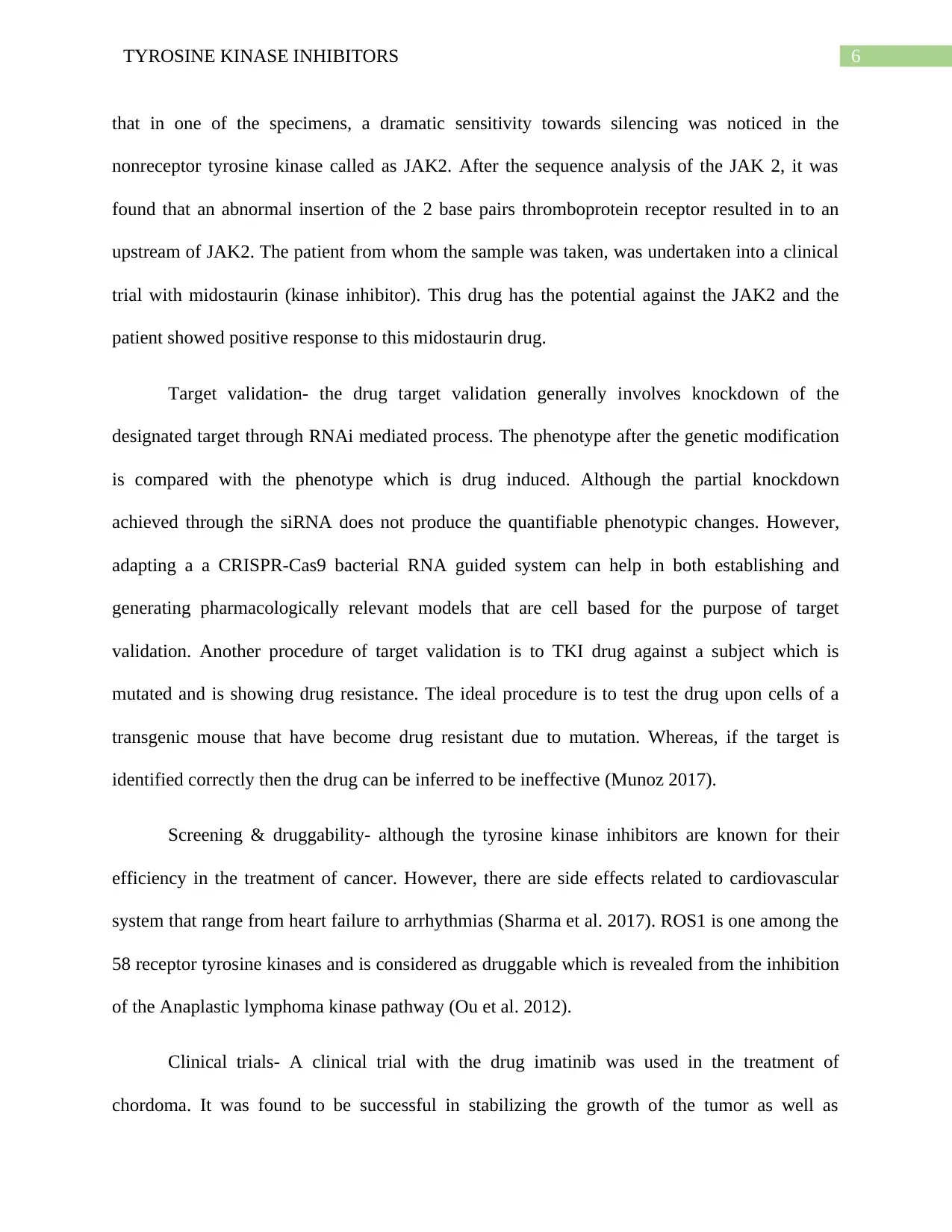
6TYROSINE KINASE INHIBITORS
that in one of the specimens, a dramatic sensitivity towards silencing was noticed in the
nonreceptor tyrosine kinase called as JAK2. After the sequence analysis of the JAK 2, it was
found that an abnormal insertion of the 2 base pairs thromboprotein receptor resulted in to an
upstream of JAK2. The patient from whom the sample was taken, was undertaken into a clinical
trial with midostaurin (kinase inhibitor). This drug has the potential against the JAK2 and the
patient showed positive response to this midostaurin drug.
Target validation- the drug target validation generally involves knockdown of the
designated target through RNAi mediated process. The phenotype after the genetic modification
is compared with the phenotype which is drug induced. Although the partial knockdown
achieved through the siRNA does not produce the quantifiable phenotypic changes. However,
adapting a a CRISPR-Cas9 bacterial RNA guided system can help in both establishing and
generating pharmacologically relevant models that are cell based for the purpose of target
validation. Another procedure of target validation is to TKI drug against a subject which is
mutated and is showing drug resistance. The ideal procedure is to test the drug upon cells of a
transgenic mouse that have become drug resistant due to mutation. Whereas, if the target is
identified correctly then the drug can be inferred to be ineffective (Munoz 2017).
Screening & druggability- although the tyrosine kinase inhibitors are known for their
efficiency in the treatment of cancer. However, there are side effects related to cardiovascular
system that range from heart failure to arrhythmias (Sharma et al. 2017). ROS1 is one among the
58 receptor tyrosine kinases and is considered as druggable which is revealed from the inhibition
of the Anaplastic lymphoma kinase pathway (Ou et al. 2012).
Clinical trials- A clinical trial with the drug imatinib was used in the treatment of
chordoma. It was found to be successful in stabilizing the growth of the tumor as well as
that in one of the specimens, a dramatic sensitivity towards silencing was noticed in the
nonreceptor tyrosine kinase called as JAK2. After the sequence analysis of the JAK 2, it was
found that an abnormal insertion of the 2 base pairs thromboprotein receptor resulted in to an
upstream of JAK2. The patient from whom the sample was taken, was undertaken into a clinical
trial with midostaurin (kinase inhibitor). This drug has the potential against the JAK2 and the
patient showed positive response to this midostaurin drug.
Target validation- the drug target validation generally involves knockdown of the
designated target through RNAi mediated process. The phenotype after the genetic modification
is compared with the phenotype which is drug induced. Although the partial knockdown
achieved through the siRNA does not produce the quantifiable phenotypic changes. However,
adapting a a CRISPR-Cas9 bacterial RNA guided system can help in both establishing and
generating pharmacologically relevant models that are cell based for the purpose of target
validation. Another procedure of target validation is to TKI drug against a subject which is
mutated and is showing drug resistance. The ideal procedure is to test the drug upon cells of a
transgenic mouse that have become drug resistant due to mutation. Whereas, if the target is
identified correctly then the drug can be inferred to be ineffective (Munoz 2017).
Screening & druggability- although the tyrosine kinase inhibitors are known for their
efficiency in the treatment of cancer. However, there are side effects related to cardiovascular
system that range from heart failure to arrhythmias (Sharma et al. 2017). ROS1 is one among the
58 receptor tyrosine kinases and is considered as druggable which is revealed from the inhibition
of the Anaplastic lymphoma kinase pathway (Ou et al. 2012).
Clinical trials- A clinical trial with the drug imatinib was used in the treatment of
chordoma. It was found to be successful in stabilizing the growth of the tumor as well as
Paraphrase This Document
Need a fresh take? Get an instant paraphrase of this document with our AI Paraphraser
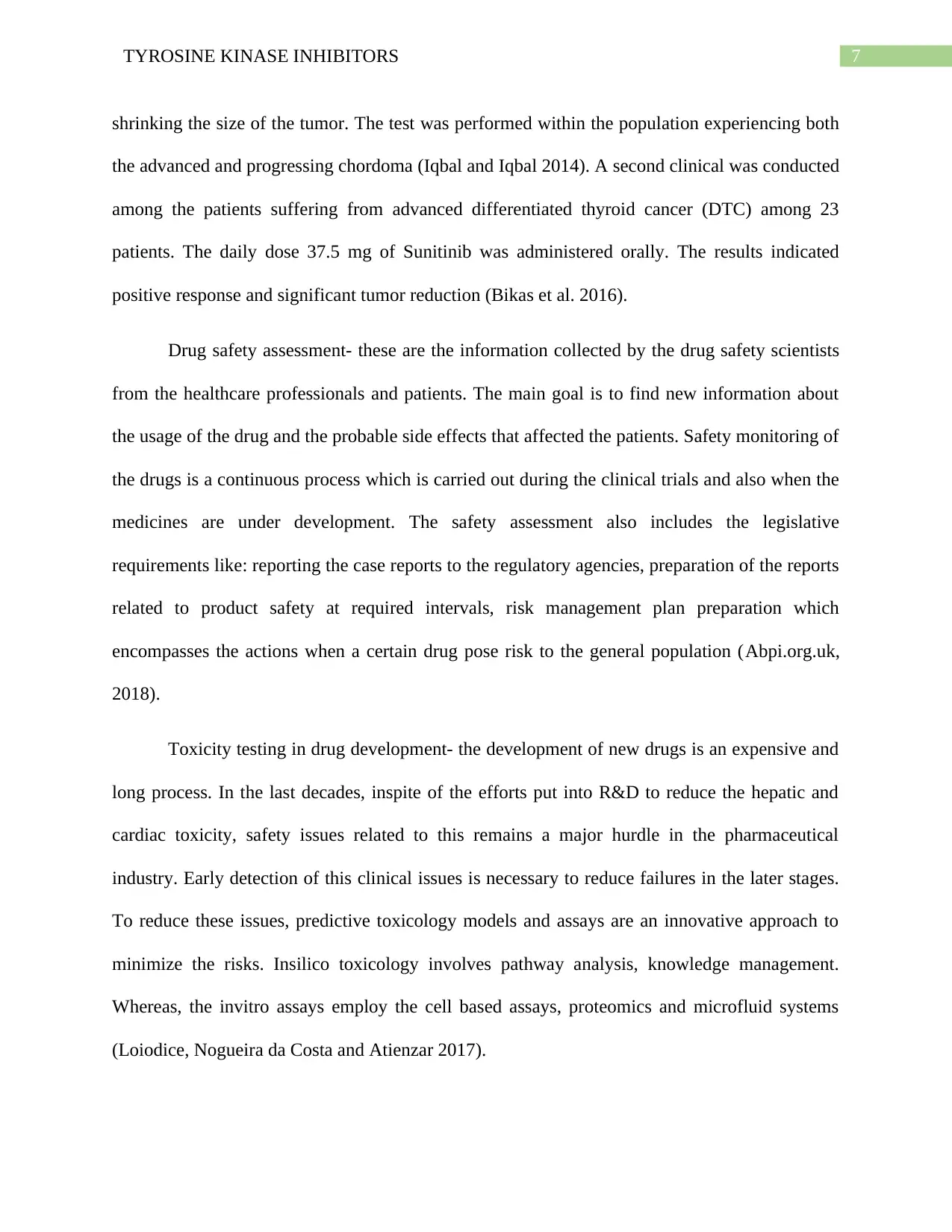
7TYROSINE KINASE INHIBITORS
shrinking the size of the tumor. The test was performed within the population experiencing both
the advanced and progressing chordoma (Iqbal and Iqbal 2014). A second clinical was conducted
among the patients suffering from advanced differentiated thyroid cancer (DTC) among 23
patients. The daily dose 37.5 mg of Sunitinib was administered orally. The results indicated
positive response and significant tumor reduction (Bikas et al. 2016).
Drug safety assessment- these are the information collected by the drug safety scientists
from the healthcare professionals and patients. The main goal is to find new information about
the usage of the drug and the probable side effects that affected the patients. Safety monitoring of
the drugs is a continuous process which is carried out during the clinical trials and also when the
medicines are under development. The safety assessment also includes the legislative
requirements like: reporting the case reports to the regulatory agencies, preparation of the reports
related to product safety at required intervals, risk management plan preparation which
encompasses the actions when a certain drug pose risk to the general population (Abpi.org.uk,
2018).
Toxicity testing in drug development- the development of new drugs is an expensive and
long process. In the last decades, inspite of the efforts put into R&D to reduce the hepatic and
cardiac toxicity, safety issues related to this remains a major hurdle in the pharmaceutical
industry. Early detection of this clinical issues is necessary to reduce failures in the later stages.
To reduce these issues, predictive toxicology models and assays are an innovative approach to
minimize the risks. Insilico toxicology involves pathway analysis, knowledge management.
Whereas, the invitro assays employ the cell based assays, proteomics and microfluid systems
(Loiodice, Nogueira da Costa and Atienzar 2017).
shrinking the size of the tumor. The test was performed within the population experiencing both
the advanced and progressing chordoma (Iqbal and Iqbal 2014). A second clinical was conducted
among the patients suffering from advanced differentiated thyroid cancer (DTC) among 23
patients. The daily dose 37.5 mg of Sunitinib was administered orally. The results indicated
positive response and significant tumor reduction (Bikas et al. 2016).
Drug safety assessment- these are the information collected by the drug safety scientists
from the healthcare professionals and patients. The main goal is to find new information about
the usage of the drug and the probable side effects that affected the patients. Safety monitoring of
the drugs is a continuous process which is carried out during the clinical trials and also when the
medicines are under development. The safety assessment also includes the legislative
requirements like: reporting the case reports to the regulatory agencies, preparation of the reports
related to product safety at required intervals, risk management plan preparation which
encompasses the actions when a certain drug pose risk to the general population (Abpi.org.uk,
2018).
Toxicity testing in drug development- the development of new drugs is an expensive and
long process. In the last decades, inspite of the efforts put into R&D to reduce the hepatic and
cardiac toxicity, safety issues related to this remains a major hurdle in the pharmaceutical
industry. Early detection of this clinical issues is necessary to reduce failures in the later stages.
To reduce these issues, predictive toxicology models and assays are an innovative approach to
minimize the risks. Insilico toxicology involves pathway analysis, knowledge management.
Whereas, the invitro assays employ the cell based assays, proteomics and microfluid systems
(Loiodice, Nogueira da Costa and Atienzar 2017).
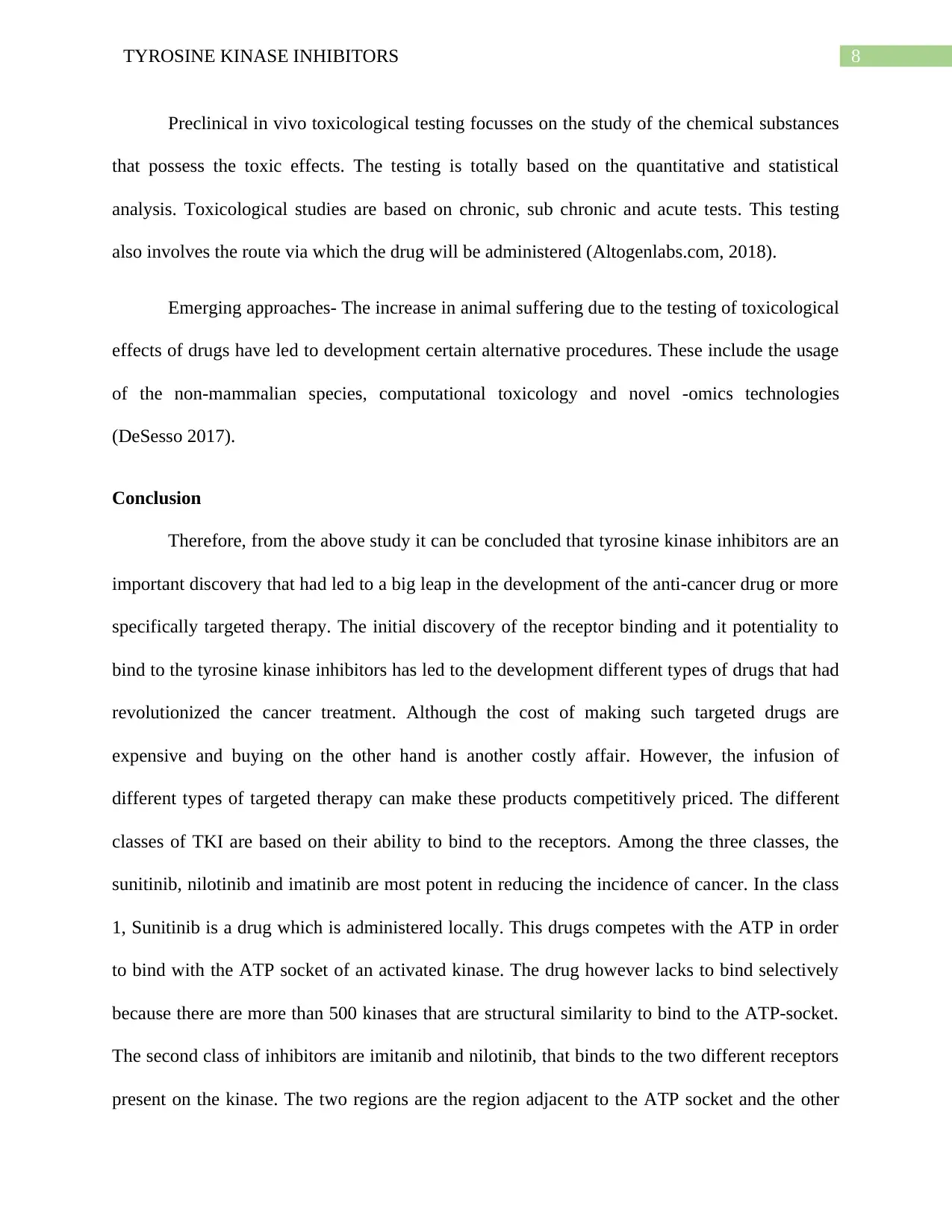
8TYROSINE KINASE INHIBITORS
Preclinical in vivo toxicological testing focusses on the study of the chemical substances
that possess the toxic effects. The testing is totally based on the quantitative and statistical
analysis. Toxicological studies are based on chronic, sub chronic and acute tests. This testing
also involves the route via which the drug will be administered (Altogenlabs.com, 2018).
Emerging approaches- The increase in animal suffering due to the testing of toxicological
effects of drugs have led to development certain alternative procedures. These include the usage
of the non-mammalian species, computational toxicology and novel -omics technologies
(DeSesso 2017).
Conclusion
Therefore, from the above study it can be concluded that tyrosine kinase inhibitors are an
important discovery that had led to a big leap in the development of the anti-cancer drug or more
specifically targeted therapy. The initial discovery of the receptor binding and it potentiality to
bind to the tyrosine kinase inhibitors has led to the development different types of drugs that had
revolutionized the cancer treatment. Although the cost of making such targeted drugs are
expensive and buying on the other hand is another costly affair. However, the infusion of
different types of targeted therapy can make these products competitively priced. The different
classes of TKI are based on their ability to bind to the receptors. Among the three classes, the
sunitinib, nilotinib and imatinib are most potent in reducing the incidence of cancer. In the class
1, Sunitinib is a drug which is administered locally. This drugs competes with the ATP in order
to bind with the ATP socket of an activated kinase. The drug however lacks to bind selectively
because there are more than 500 kinases that are structural similarity to bind to the ATP-socket.
The second class of inhibitors are imitanib and nilotinib, that binds to the two different receptors
present on the kinase. The two regions are the region adjacent to the ATP socket and the other
Preclinical in vivo toxicological testing focusses on the study of the chemical substances
that possess the toxic effects. The testing is totally based on the quantitative and statistical
analysis. Toxicological studies are based on chronic, sub chronic and acute tests. This testing
also involves the route via which the drug will be administered (Altogenlabs.com, 2018).
Emerging approaches- The increase in animal suffering due to the testing of toxicological
effects of drugs have led to development certain alternative procedures. These include the usage
of the non-mammalian species, computational toxicology and novel -omics technologies
(DeSesso 2017).
Conclusion
Therefore, from the above study it can be concluded that tyrosine kinase inhibitors are an
important discovery that had led to a big leap in the development of the anti-cancer drug or more
specifically targeted therapy. The initial discovery of the receptor binding and it potentiality to
bind to the tyrosine kinase inhibitors has led to the development different types of drugs that had
revolutionized the cancer treatment. Although the cost of making such targeted drugs are
expensive and buying on the other hand is another costly affair. However, the infusion of
different types of targeted therapy can make these products competitively priced. The different
classes of TKI are based on their ability to bind to the receptors. Among the three classes, the
sunitinib, nilotinib and imatinib are most potent in reducing the incidence of cancer. In the class
1, Sunitinib is a drug which is administered locally. This drugs competes with the ATP in order
to bind with the ATP socket of an activated kinase. The drug however lacks to bind selectively
because there are more than 500 kinases that are structural similarity to bind to the ATP-socket.
The second class of inhibitors are imitanib and nilotinib, that binds to the two different receptors
present on the kinase. The two regions are the region adjacent to the ATP socket and the other
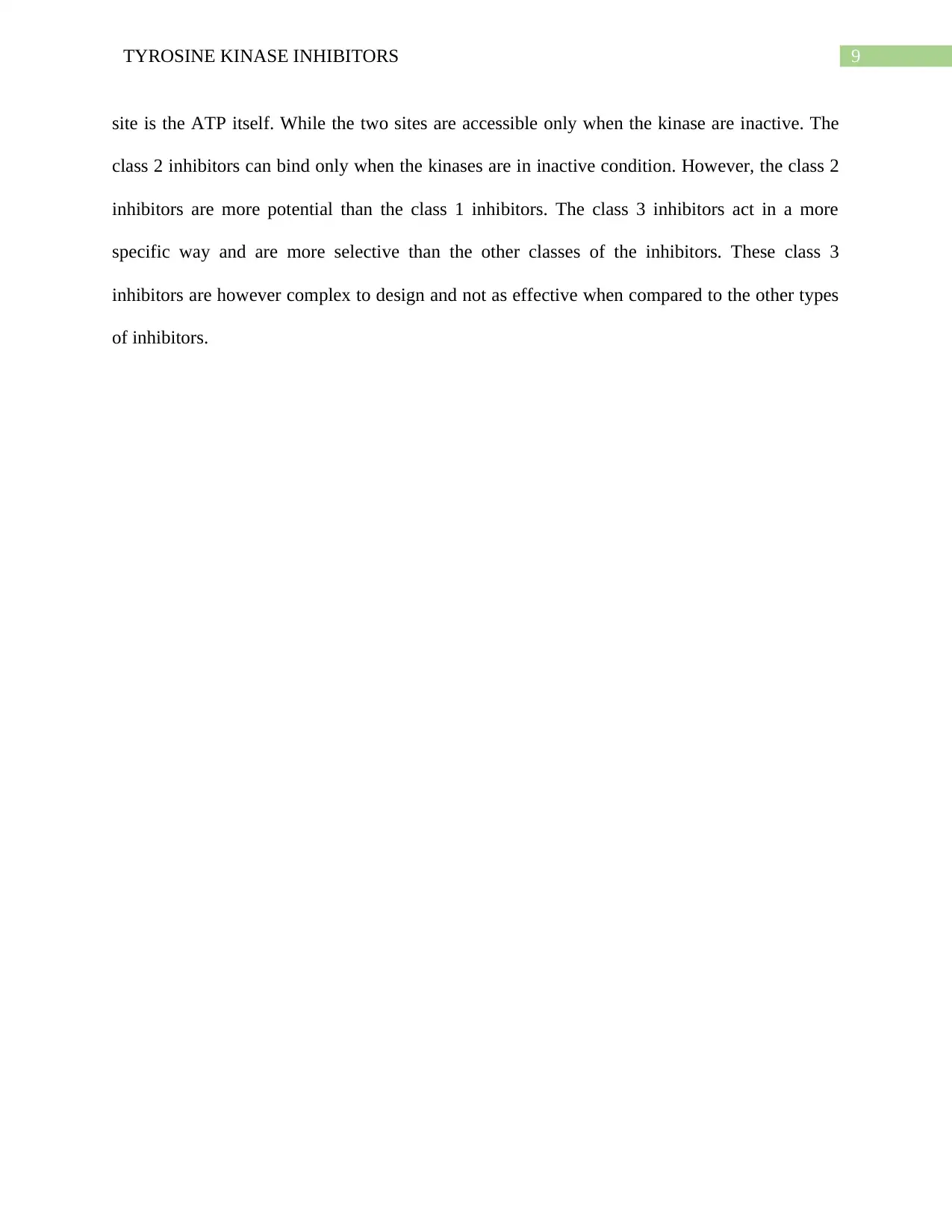
9TYROSINE KINASE INHIBITORS
site is the ATP itself. While the two sites are accessible only when the kinase are inactive. The
class 2 inhibitors can bind only when the kinases are in inactive condition. However, the class 2
inhibitors are more potential than the class 1 inhibitors. The class 3 inhibitors act in a more
specific way and are more selective than the other classes of the inhibitors. These class 3
inhibitors are however complex to design and not as effective when compared to the other types
of inhibitors.
site is the ATP itself. While the two sites are accessible only when the kinase are inactive. The
class 2 inhibitors can bind only when the kinases are in inactive condition. However, the class 2
inhibitors are more potential than the class 1 inhibitors. The class 3 inhibitors act in a more
specific way and are more selective than the other classes of the inhibitors. These class 3
inhibitors are however complex to design and not as effective when compared to the other types
of inhibitors.
Secure Best Marks with AI Grader
Need help grading? Try our AI Grader for instant feedback on your assignments.
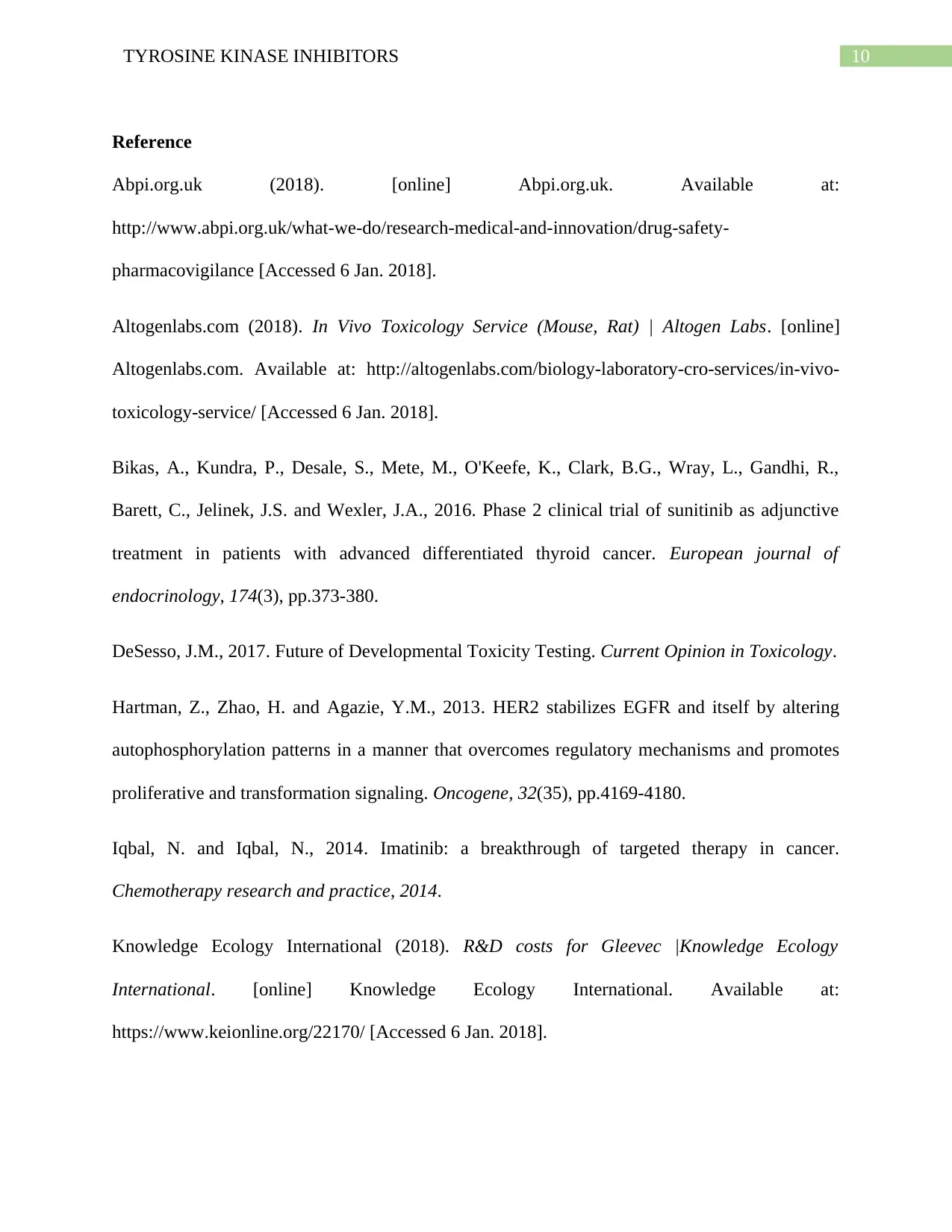
10TYROSINE KINASE INHIBITORS
Reference
Abpi.org.uk (2018). [online] Abpi.org.uk. Available at:
http://www.abpi.org.uk/what-we-do/research-medical-and-innovation/drug-safety-
pharmacovigilance [Accessed 6 Jan. 2018].
Altogenlabs.com (2018). In Vivo Toxicology Service (Mouse, Rat) | Altogen Labs. [online]
Altogenlabs.com. Available at: http://altogenlabs.com/biology-laboratory-cro-services/in-vivo-
toxicology-service/ [Accessed 6 Jan. 2018].
Bikas, A., Kundra, P., Desale, S., Mete, M., O'Keefe, K., Clark, B.G., Wray, L., Gandhi, R.,
Barett, C., Jelinek, J.S. and Wexler, J.A., 2016. Phase 2 clinical trial of sunitinib as adjunctive
treatment in patients with advanced differentiated thyroid cancer. European journal of
endocrinology, 174(3), pp.373-380.
DeSesso, J.M., 2017. Future of Developmental Toxicity Testing. Current Opinion in Toxicology.
Hartman, Z., Zhao, H. and Agazie, Y.M., 2013. HER2 stabilizes EGFR and itself by altering
autophosphorylation patterns in a manner that overcomes regulatory mechanisms and promotes
proliferative and transformation signaling. Oncogene, 32(35), pp.4169-4180.
Iqbal, N. and Iqbal, N., 2014. Imatinib: a breakthrough of targeted therapy in cancer.
Chemotherapy research and practice, 2014.
Knowledge Ecology International (2018). R&D costs for Gleevec |Knowledge Ecology
International. [online] Knowledge Ecology International. Available at:
https://www.keionline.org/22170/ [Accessed 6 Jan. 2018].
Reference
Abpi.org.uk (2018). [online] Abpi.org.uk. Available at:
http://www.abpi.org.uk/what-we-do/research-medical-and-innovation/drug-safety-
pharmacovigilance [Accessed 6 Jan. 2018].
Altogenlabs.com (2018). In Vivo Toxicology Service (Mouse, Rat) | Altogen Labs. [online]
Altogenlabs.com. Available at: http://altogenlabs.com/biology-laboratory-cro-services/in-vivo-
toxicology-service/ [Accessed 6 Jan. 2018].
Bikas, A., Kundra, P., Desale, S., Mete, M., O'Keefe, K., Clark, B.G., Wray, L., Gandhi, R.,
Barett, C., Jelinek, J.S. and Wexler, J.A., 2016. Phase 2 clinical trial of sunitinib as adjunctive
treatment in patients with advanced differentiated thyroid cancer. European journal of
endocrinology, 174(3), pp.373-380.
DeSesso, J.M., 2017. Future of Developmental Toxicity Testing. Current Opinion in Toxicology.
Hartman, Z., Zhao, H. and Agazie, Y.M., 2013. HER2 stabilizes EGFR and itself by altering
autophosphorylation patterns in a manner that overcomes regulatory mechanisms and promotes
proliferative and transformation signaling. Oncogene, 32(35), pp.4169-4180.
Iqbal, N. and Iqbal, N., 2014. Imatinib: a breakthrough of targeted therapy in cancer.
Chemotherapy research and practice, 2014.
Knowledge Ecology International (2018). R&D costs for Gleevec |Knowledge Ecology
International. [online] Knowledge Ecology International. Available at:
https://www.keionline.org/22170/ [Accessed 6 Jan. 2018].
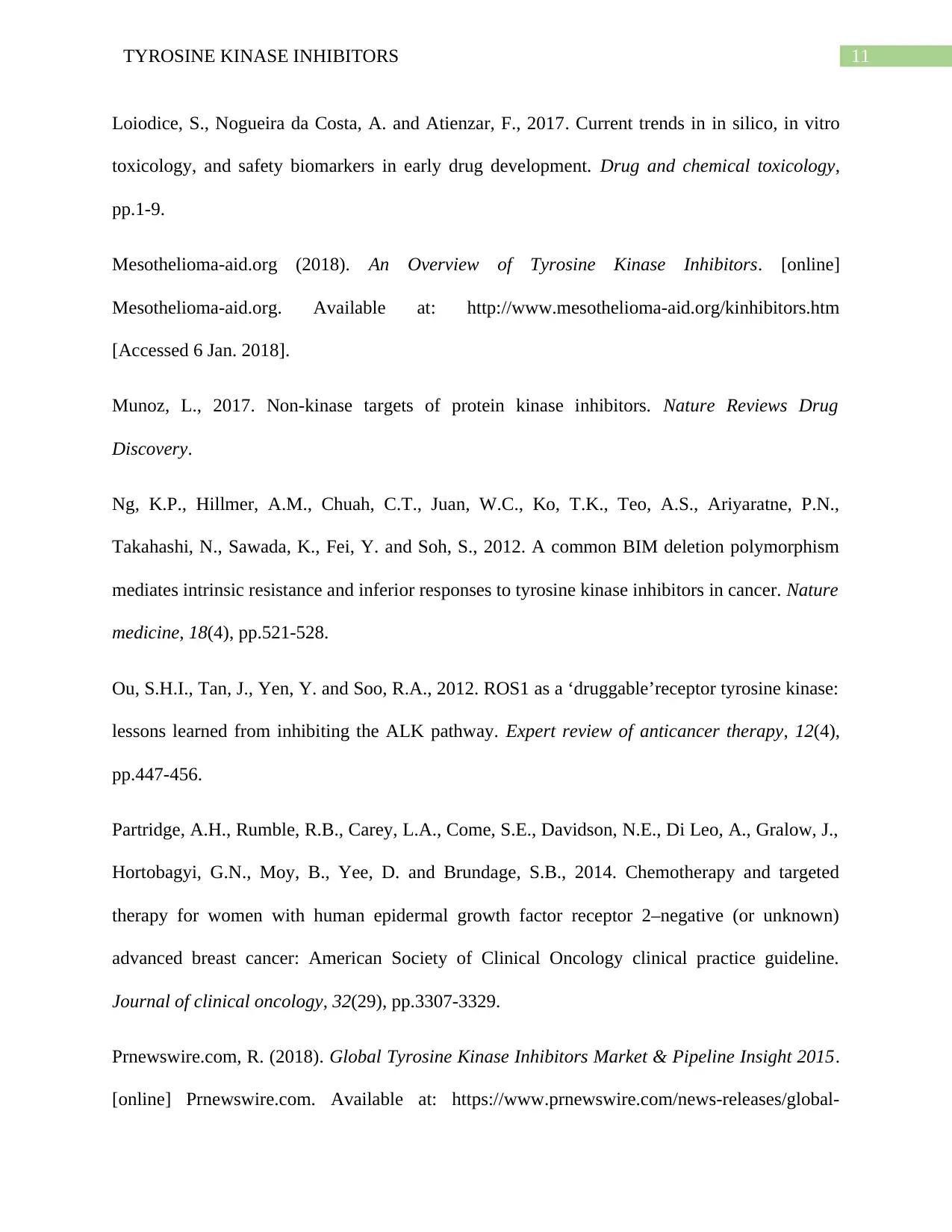
11TYROSINE KINASE INHIBITORS
Loiodice, S., Nogueira da Costa, A. and Atienzar, F., 2017. Current trends in in silico, in vitro
toxicology, and safety biomarkers in early drug development. Drug and chemical toxicology,
pp.1-9.
Mesothelioma-aid.org (2018). An Overview of Tyrosine Kinase Inhibitors. [online]
Mesothelioma-aid.org. Available at: http://www.mesothelioma-aid.org/kinhibitors.htm
[Accessed 6 Jan. 2018].
Munoz, L., 2017. Non-kinase targets of protein kinase inhibitors. Nature Reviews Drug
Discovery.
Ng, K.P., Hillmer, A.M., Chuah, C.T., Juan, W.C., Ko, T.K., Teo, A.S., Ariyaratne, P.N.,
Takahashi, N., Sawada, K., Fei, Y. and Soh, S., 2012. A common BIM deletion polymorphism
mediates intrinsic resistance and inferior responses to tyrosine kinase inhibitors in cancer. Nature
medicine, 18(4), pp.521-528.
Ou, S.H.I., Tan, J., Yen, Y. and Soo, R.A., 2012. ROS1 as a ‘druggable’receptor tyrosine kinase:
lessons learned from inhibiting the ALK pathway. Expert review of anticancer therapy, 12(4),
pp.447-456.
Partridge, A.H., Rumble, R.B., Carey, L.A., Come, S.E., Davidson, N.E., Di Leo, A., Gralow, J.,
Hortobagyi, G.N., Moy, B., Yee, D. and Brundage, S.B., 2014. Chemotherapy and targeted
therapy for women with human epidermal growth factor receptor 2–negative (or unknown)
advanced breast cancer: American Society of Clinical Oncology clinical practice guideline.
Journal of clinical oncology, 32(29), pp.3307-3329.
Prnewswire.com, R. (2018). Global Tyrosine Kinase Inhibitors Market & Pipeline Insight 2015.
[online] Prnewswire.com. Available at: https://www.prnewswire.com/news-releases/global-
Loiodice, S., Nogueira da Costa, A. and Atienzar, F., 2017. Current trends in in silico, in vitro
toxicology, and safety biomarkers in early drug development. Drug and chemical toxicology,
pp.1-9.
Mesothelioma-aid.org (2018). An Overview of Tyrosine Kinase Inhibitors. [online]
Mesothelioma-aid.org. Available at: http://www.mesothelioma-aid.org/kinhibitors.htm
[Accessed 6 Jan. 2018].
Munoz, L., 2017. Non-kinase targets of protein kinase inhibitors. Nature Reviews Drug
Discovery.
Ng, K.P., Hillmer, A.M., Chuah, C.T., Juan, W.C., Ko, T.K., Teo, A.S., Ariyaratne, P.N.,
Takahashi, N., Sawada, K., Fei, Y. and Soh, S., 2012. A common BIM deletion polymorphism
mediates intrinsic resistance and inferior responses to tyrosine kinase inhibitors in cancer. Nature
medicine, 18(4), pp.521-528.
Ou, S.H.I., Tan, J., Yen, Y. and Soo, R.A., 2012. ROS1 as a ‘druggable’receptor tyrosine kinase:
lessons learned from inhibiting the ALK pathway. Expert review of anticancer therapy, 12(4),
pp.447-456.
Partridge, A.H., Rumble, R.B., Carey, L.A., Come, S.E., Davidson, N.E., Di Leo, A., Gralow, J.,
Hortobagyi, G.N., Moy, B., Yee, D. and Brundage, S.B., 2014. Chemotherapy and targeted
therapy for women with human epidermal growth factor receptor 2–negative (or unknown)
advanced breast cancer: American Society of Clinical Oncology clinical practice guideline.
Journal of clinical oncology, 32(29), pp.3307-3329.
Prnewswire.com, R. (2018). Global Tyrosine Kinase Inhibitors Market & Pipeline Insight 2015.
[online] Prnewswire.com. Available at: https://www.prnewswire.com/news-releases/global-
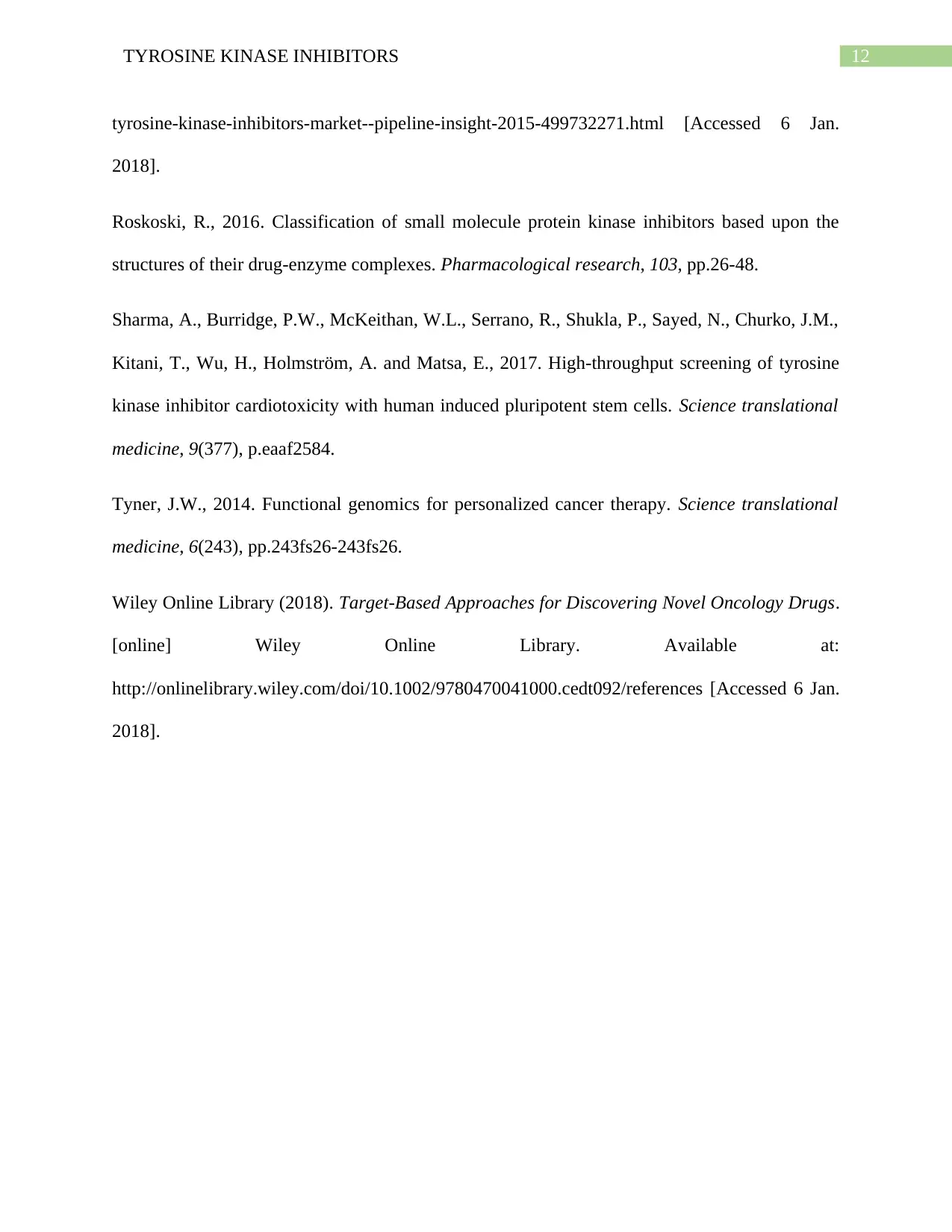
12TYROSINE KINASE INHIBITORS
tyrosine-kinase-inhibitors-market--pipeline-insight-2015-499732271.html [Accessed 6 Jan.
2018].
Roskoski, R., 2016. Classification of small molecule protein kinase inhibitors based upon the
structures of their drug-enzyme complexes. Pharmacological research, 103, pp.26-48.
Sharma, A., Burridge, P.W., McKeithan, W.L., Serrano, R., Shukla, P., Sayed, N., Churko, J.M.,
Kitani, T., Wu, H., Holmström, A. and Matsa, E., 2017. High-throughput screening of tyrosine
kinase inhibitor cardiotoxicity with human induced pluripotent stem cells. Science translational
medicine, 9(377), p.eaaf2584.
Tyner, J.W., 2014. Functional genomics for personalized cancer therapy. Science translational
medicine, 6(243), pp.243fs26-243fs26.
Wiley Online Library (2018). Target-Based Approaches for Discovering Novel Oncology Drugs.
[online] Wiley Online Library. Available at:
http://onlinelibrary.wiley.com/doi/10.1002/9780470041000.cedt092/references [Accessed 6 Jan.
2018].
tyrosine-kinase-inhibitors-market--pipeline-insight-2015-499732271.html [Accessed 6 Jan.
2018].
Roskoski, R., 2016. Classification of small molecule protein kinase inhibitors based upon the
structures of their drug-enzyme complexes. Pharmacological research, 103, pp.26-48.
Sharma, A., Burridge, P.W., McKeithan, W.L., Serrano, R., Shukla, P., Sayed, N., Churko, J.M.,
Kitani, T., Wu, H., Holmström, A. and Matsa, E., 2017. High-throughput screening of tyrosine
kinase inhibitor cardiotoxicity with human induced pluripotent stem cells. Science translational
medicine, 9(377), p.eaaf2584.
Tyner, J.W., 2014. Functional genomics for personalized cancer therapy. Science translational
medicine, 6(243), pp.243fs26-243fs26.
Wiley Online Library (2018). Target-Based Approaches for Discovering Novel Oncology Drugs.
[online] Wiley Online Library. Available at:
http://onlinelibrary.wiley.com/doi/10.1002/9780470041000.cedt092/references [Accessed 6 Jan.
2018].
1 out of 13
Your All-in-One AI-Powered Toolkit for Academic Success.
+13062052269
info@desklib.com
Available 24*7 on WhatsApp / Email
![[object Object]](/_next/static/media/star-bottom.7253800d.svg)
Unlock your academic potential
© 2024 | Zucol Services PVT LTD | All rights reserved.


